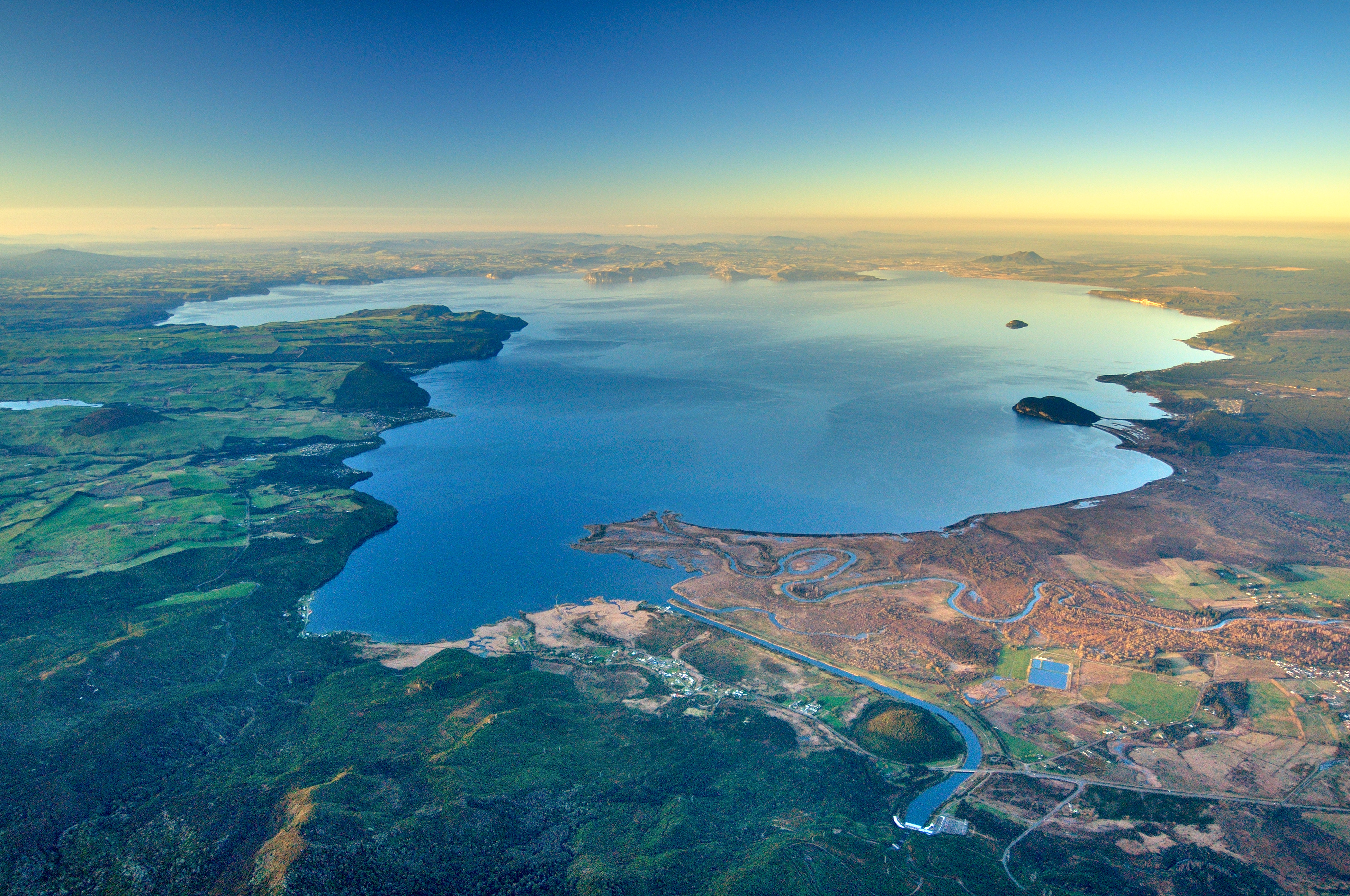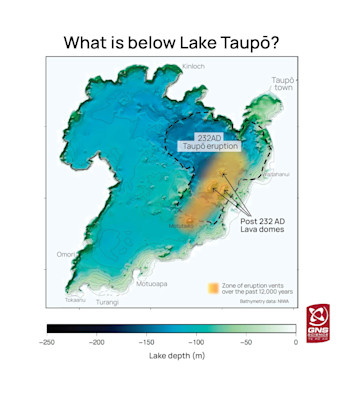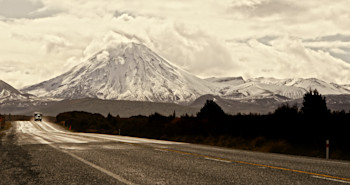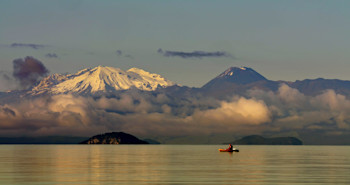
When Taupō erupts it’ll be huge, right?
This is a question we at GeoNet have been hearing a lot since the increase of the Volcanic Alert Level for Taupō Volcano in September 2022. (Spoiler – it's extremely unlikely to be a huge eruption if it did erupt.) So today we take a closer look at the history of Taupō volcano, and what could happen in the future.
The northern portion of the beautiful Lake Taupō that we know, and love was created about 25,500 years ago during the exceptionally large Ōruanui Eruption. This was a ‘super eruption’ with over 1,000 cubic kilometres of pumice and ash being rapidly ejected, causing a large area of land to collapse and forming the ‘caldera’ basin, now filled by water. A second caldera-forming eruption, the 'Taupō eruption', occurred about 1800 years ago in 232AD.
Although Taupō volcano is capable of caldera forming eruptions, such as the Ōruanui and Taupō eruptions, they are rare in the context of the past 25,000 years. There have been 28 eruptions at Taupō volcano, and all but two have been far smaller than those that everyone thinks of when they imagine a Taupō volcano eruption.
The history of eruptions at Taupō Volcano
When we look back at those 28 eruptions over the past 25,000 years, we can divide them into three size groups: small, medium, and large.
Small eruptions: These are up to 0.1 cubic kilometres of magma erupted (1/10th the volume of Mt Ngauruhoe). There have been 15 small eruptions in the last 25,000 years.
Medium eruptions: These range from greater than 0.1 to 2 cubic kilometres of magma erupted. There have been 11 medium sized eruptions in the last 25,000 years. The biggest of these were about three times the size of Mt Tarawera’s eruption in 1886 (which was 0.7 cubic km).
Large eruptions: There have only been two eruptions bigger than 2 cubic kilometres in the last 25,000 years. The most recent was the 232AD 'Taupō eruption', 1800 years ago. This eruption had an estimated volume of 35 cubic kilometres. The second was the Waimihia eruption 3500 years ago, which was about 7.5 cubic kilometres in size (think a magma volume 7x bigger than the volume of Mt Ngauruhoe).
We have used cubic kilometres of magma erupted as the standard size unit for these big eruptions, so how much is a cubic kilometre? If you can visualise the view of Mt Ngauruhoe as you drive along the Desert Road, the cone of the mountain is about 1 cubic kilometre in volume. Note that pumice and ash froth up a lot as it erupts - up to 3-4 times the magma volume.
Taupō Volcano’s eruptions in the last 26,000 years
| Eruption Type | Size (magma) | Comparison | How Many |
|---|---|---|---|
| Small Eruption | Up to 0.1 cubic kilometres | Up to 1/10th the volume of Mt Ngauruhoe | 15 |
| Medium eruption | Greater than 0.1 to 2 cubic kilometres | Up to 3x Mt Tarawera eruption | 11 |
| Large eruption | Greater than 2 to 50 cubic kilometres | 3 to 70x Tarawera 1886 eruption | 2: Taupō, Waimihia |
| Super eruption | More than 1000 cubic kilometres | Qualifies as a 'super eruption' | 1: Ōruanui |
Volcanic Unrest
Between eruptions calderas can undergo periods of unrest. Volcanic unrest involves magma and fluids moving beneath the volcano. This can result in earthquakes, ground movement, and gas/fluid release. Unrest can occur over years to decades and is very common globally – and is happening at Taupō Volcano right now. The recent M5.7 Taupō earthquake was part of the volcanic unrest.
Caldera volcanoes do not erupt without first experiencing volcanic unrest. While volcanic unrest means that an eruption is more likely, Taupō has had at least 18 episodes of unrest in the past 150 years, lasting for months to years, and none of them have led to an eruption. Based on this history, the current unrest period could continue for weeks to months, at varying intensities.
For a large volcanic eruption to occur, we would expect to see much more unrest than we’ve seen in 2022, or the last 150 years of recorded activity, and for it to go on for many years. The chance of an eruption occurring after only a few months of minor unrest is extremely low.
What could happen if Taupō erupted in the future?
The most likely scenario for the current activity at Lake Taupō is that unrest continues for several months, and then dies down again, and the Volcanic Alert Level is lowered to zero.
However, if volcanic unrest did increase over time, and the volcano was to have a small eruption (if we take a small, more common eruption from Taupō Volcano) the volume could be about 0.1 cubic kilometers.
Lakeside communities would need to evacuate as they could be impacted by thick ashfall and life-threatening hazards near the vent, such as hot ash flows and flying rocks. Ash blows with the wind, with thicker ashfall landing closer to the vent, so the areas affected will depend on the wind direction and strength. Assuming a westerly is blowing, the road on the east side of the lake and through to Napier would likely be closed due to ashfall. The Napier and Hastings regions would also be impacted by ashfall. Water supplies and electricity networks in the area would likely be disrupted. You can find out more about volcanic ash and it’s possible impacts here. And read more on volcanic hazards here.
More Information:
YouTube video on historical Taupō unrest
Caldera Unrest Management Sourcebook
ECLIPSE caldera volcano research programme led by VUW, GNS Science and Massey University
We can’t prevent natural hazards, but we can, and should, be prepared for them
Drop, Cover, and Hold during a large earthquake. If it is Long or Strong, Get Gone! People near the lake front should move to higher ground as soon as it is safe to do so, especially if they hear loud noises or see unusual lake action during earthquake activity. During volcanic activity, follow official advice provided by your local Civil Defence Emergency Management Group.
Information about Civil Defence in the Taupō District can be found here.
For information on preparing for earthquakes or responding to volcanic activity, there are guidelines from the National Emergency Management Agency's (NEMA) Get Ready website.
Prepare your home. Protect your whānau.
There’s a lot we can do to make our homes safer and stronger for earthquakes. Toka Tū Ake EQC’s website has key steps to get you started.
All right? / Not All Right?
We understand that some people might find changing the alert level at Taupō or the recent earthquakes unsettling. The All Right? website has great resources where you can read and talk about any concerns that you have.
Media enquiries: media@gns.cri.nz or 021 574 541





